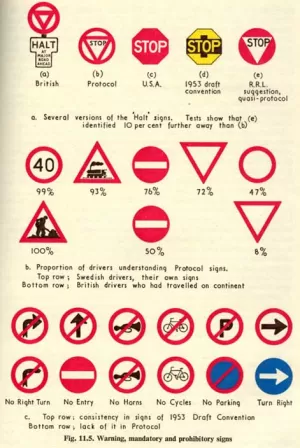
As for signs on all-purpose roads, even following the 1955 review and subsequent 1957 regulations, the Ministry's designs remained little more than 'best practice' guidelines. Any authority erecting a sign was simply advised to use the signs. There was some discussion of carrying out a thorough update to the whole system of signing - which materialised in the later Worboys Committee - but until that time, signposting remained surprisingly disorganised, to the extent that several local authorities decided to ignore the regulations completely.
Between 1955 and 1957, the Road Research Laboratory conducted a series of experiments in Slough. Numerous diagrammatic signs were erected, in black on a white or yellow background, for junctions around the town. The signs used different combinations of destination and route number and altered the relative prominence of the two in an attempt to find out which combination produced the simplest navigation for the smallest sign area.
For many years, Oxfordshire County Council paid no attention to any government guidelines and set up its own system of signs, which used mixed-case lettering in black on white. The typeface used appears to have been a version of MOT Serif that was modified to include a full upper and lowercase alphabet, though apparently after the Anderson Committee reported, Oxfordshire started using the Transport typeface as some images show these signs with the new font. All of these unusual signs have now been removed, but survived until the 1990s in some places. The Worboys report mentioned them specifically, though only to describe their black background as "funereal".

Following the acceptance of the Anderson Committee's report, the Ministry of Transport appointed the Adams Committee to adapt the design of the signs for use on dual carriageway non-motorway roads. These included new diagrams for at-grade junctions and other off-motorway hazards, and used white text on a dark green background (including for plates underneath warning signs). By the time these were produced and in use, it was known that the Worboys Committee would produce new specifications for traffic signs in the near future and they were only intended as a temporary solution. Nonetheless they were used successfully on a number of roads, including the Stamford Bypass. The Committee ended up using the white-on-green colours of these signs for primary routes.
Worboys drafts
In arriving at their final set of designs, the Worboys Committee considered a wide range of ideas. As well as examining the standard European designs and the protocols of the Vienna Convention (which established international standards in traffic signs), the Committee came up with a number of ideas of its own.
For example, images exist of some of the experimental signs that were erected. One shows that italicised route numbers on B-roads were under consideration. Others show that for a time the Committee wanted to add diagonal bars across many signs that the Vienna Convention left open - such as "no pedestrians", "no cyclists", and very oddly, "no overtaking".
While the Committee eventually agreed that local direction signs would retain the blue border they gained in the 1955 regulations, a proposal that appeared concrete at draft stage but which did not make the final report was to have minor road signing in urban areas in black on yellow - this was so serious for a time that numerous test signs were erected across London.
Some of the ideas above were removed from the draft so late that they were reported in some places as features of the new traffic sign system.


